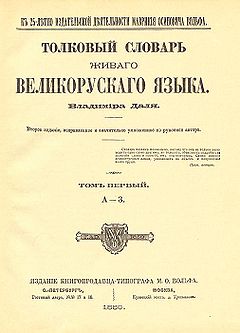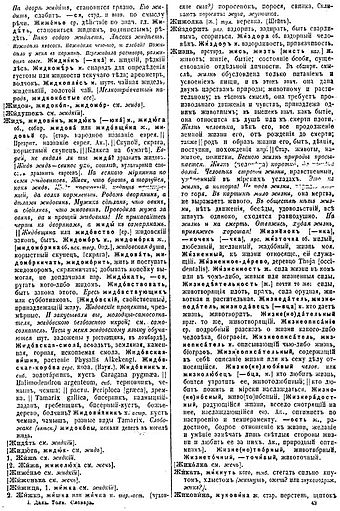- Explanatory Dictionary of the Living Great Russian Language
-
Explanatory Dictionary of the Living Great Russian Language 
Vol.1 of the 1880 editionAuthor(s) Vladimir Dahl Original title Толковый словарь живого великорусского языка Country Russian Empire Language Russian Subject(s) General Genre(s) Reference encyclopedia Publisher M. O. Wolf Publication date 1863 and on Media type 4 volumes (hardbound) The Explanatory Dictionary of the Living Great Russian Language (Russian: Толко́вый слова́рь живо́го великору́сского языка́), commonly known as Dahl’s Explanatory Dictionary (Russian: Толко́вый слова́рь Да́ля) is one of the major explanatory dictionaries of the Russian language. Contains about 200,000 words and 30,000 proverbs. Collected, edited and published by Vladimir Ivanovich Dahl (Russian: Влади́мир Ива́нович Даль), one of the most prominent Russian language lexicographers and folklore collectors of the 19th century.
Dahl’s Explanatory Dictionary of the Great Russian language was the only ample dictionary repeatedly (1935, 1955) reprinted in the Soviet Union in compliance with the old rules of spelling and alphabet, which were repealed in 1918.
Contents
History and features
Author shows his specific understanding of the Russian language just from the cover of his vocabulary. There he simplifies the spelling of word "Russian", rejecting the duplication of letter "s". In old Russian spelling it looks like
- Russian: Толковый словарь живаго великорускаго языка
However, this is a unique type of spelling deviations from the standard grammar, upon which the V. I. Dahl insisted. In his basic speeches at the Russian Geographical Society (traditionally they are published together with his forewords in a preface to the edition) academician Dahl opposes the "illiterate" distortion of words in vulgar parlance. However he distinguishes between these distortions and regional dialectical variations which he has been meticulously collecting during decades in his travels around Russia, from Europe to Siberia.[1]
Another methodological principle which V. I. Dahl rigorously perceived was the rejection of usage of transliterated or transcribed foreign-language roots as base words in favour of translation relying upon original Russian roots.[2] However certain loanwords like "проспект" (Prospekt (street)) were included.
Editions
Vladimir Dahl (1801–1872) witnessed only the first edition of his dictionary. The editors of the posthumous 2d edition (1880–1883) expanded it using the author's words cards, but following the norms of Russian public morality abstained from adding entries with obscene words.
In 1903 the linguist Baudouin de Courtenay as an editor insisted upon including obscene words in the 3rd edition. Although this decision was criticized by moralists, the edition sold well, and so in 1912–1914 it was released again as a 4th edition.
The 5th edition undertaken in 1935, supported by Joseph Stalin, had a very high cultural significance since it was printed in old "spelling" repealed in 1918 in the context of Reforms of Russian orthography thus providing continuity in the perception of pre-revolutionary literature by the new generations of readers. This edition was based upon the 2nd edition of 1880–1883; the Baudouin de Courtenay edition was never reprinted in Soviet times.
Twenty years later, in 1955, the dictionary was reprinted in the Soviet Union again with a circulation of 100,000. This 6th edition was also relying upon the edition of 1880–1883 (i.e. without obscene lexics). Books of the 2nd edition were used as the source for the stereotype (photographically reproduced) reprint. However this was not an exact reproduction of an original, for the derivatives of the root жид (jew) were cut out from page 541 of volume 1.
This ambiguous censorship exemption stems from the controversy between the usage of two roots which are concurrently used in Russian as well as in many other European languages. Although Russian: жид is equivalent to Czech: žid, English: jew; while Russian: еврей corresponds to Czech: hebrejci and English: hebrew, the first form, widely used in Russian literature through the 19th century (Lermontov, Gogol et al.) subsequently became treated as an expletive with a tinge of antisemitism. To ensure the political correctness, in 1955 the editors of Dictionary decided to cut out the entire entry, keeping the volume pagination by manual increase of line spacing on the censored page. Along with disputable entries a derivative from Russian: жидкий (liquid) – the verb Russian: жидеть (to dilute, to become "more liquid") – also disappeared from this page in the 1955 edition.
- Толковый словарь живого великорусского языка. I–IV (1st ed.). М., СПб.: О-во любителей российской словесности. 1863–1866.
- Толковый словарь живого великорусского языка. I–IV (2nd ed.). СПб., М.: М. О. Вольф. 1880–1883.
- Толковый словарь живого великорусского языка. I–IV (3rd ed.). СПб., М.: М. О. Вольф. 1903–1909. "Ed. by Prof. Baudouin de Courtenay"
- Толковый словарь живого великорусского языка. I–IV (4th ed.). СПб., М.: М. О. Вольф. 1912–1914. "Ed. by Prof. Baudouin de Courtenay"
- Вл. Даль. Толковый словарь. I–IV (5th ed.). М.: ОГИЗ, 1935.
- Вл. Даль. Толковый словарь живого великорусского языка. I–IV (6th ed.). М.: Гос. изд-во иностр. и национ. словарей, 1955.
See also
- Explanatory Dictionary of the Russian Language (Ushakov)
Sources
- Terras, Victor, Handbook of Russian Literature (Yale University Press, 1990), ISBN 0300048688
References
- ^ "Толковый словарь живого великорусского языка" (in ru). (Explanatory Dictionary of the Living Great Russian Language). Vol. I. (6th ed.). М.: Гос. изд-во иностр. и национ. словарей. 1955. pp. XIII–LXXXVIII.
- ^ "Толковый словарь живого великорусского языка" (in ru). (Explanatory Dictionary of the Living Great Russian Language). Vol. I. (6th ed.). М.: Гос. изд-во иностр. и национ. словарей. 1955. pp. III–X.
External links
- "Толковый словарь Даля онлайн [Dahl’s Explanatory Dictionary Online]" (in Russian). http://slovardalja.net/. Retrieved February, 11 2011.
- "Searchable version of Dahl’s, Ushakov’s and Ozhegov’s dictionaries" (in Russian language). http://dic.academic.ru/searchall.php?SWord=&s=1&t=1&d=1. Retrieved February, 11 2011.
Categories:- Russian dictionaries
Wikimedia Foundation. 2010.

